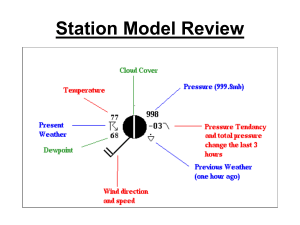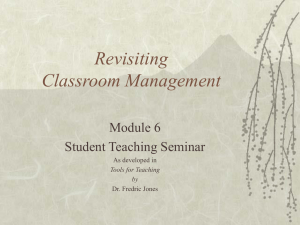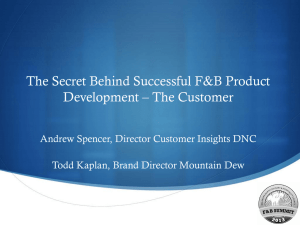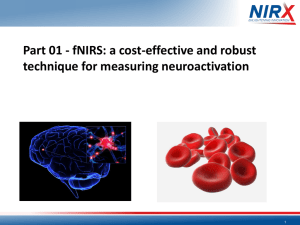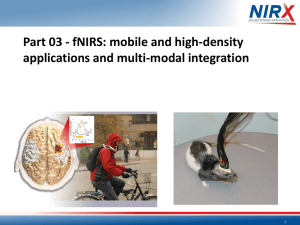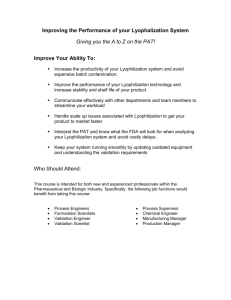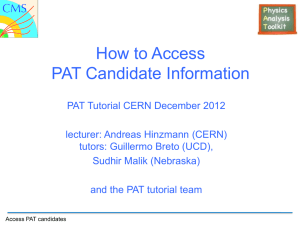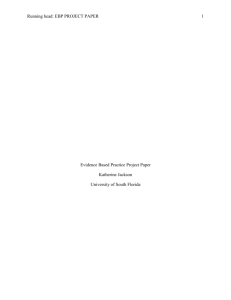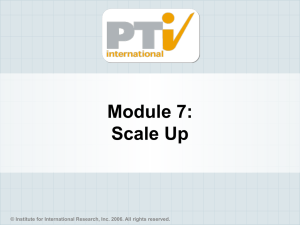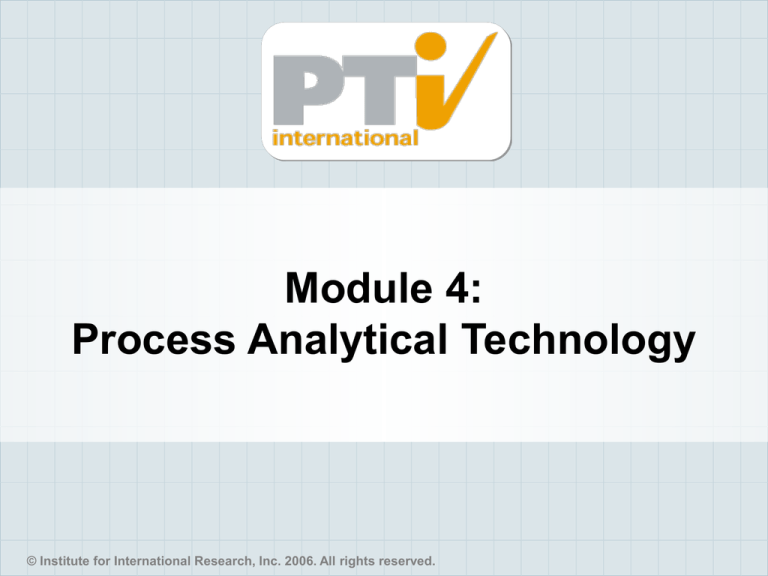
Module 4:
Process Analytical Technology
© Institute for International Research, Inc. 2006. All rights reserved.
Module 4 Purpose and Objectives
Module Purpose:
Examine PAT in the context of lyophilization
Module Objectives:
After this module, you will
Have been introduced to the instrumentation
used in lyophilization
Argue for or against PAT proposals
2
international
Process Analytical Technology
A desired goal of the PAT framework is to
design and develop processes that can
consistently ensure a predefined quality at the
end of the manufacturing process. Such
procedures would be consistent with the basic
tenet of quality by design and could reduce
risks to quality and regulatory concerns while
improving efficiency. Gains in quality, safety
and/or efficiency will vary depending on the
product and are likely to come from:
3
international
Process Analytical Technology
Reducing production cycle times by using on-, in-,
and/or at-line measurements and controls.
Preventing rejects, scrap, and re-processing.
Considering the possibility of real time release.
Increasing automation to improve operator safety and
reduce human error.
Facilitating continuous processing to improve efficiency
and manage variability
Using small-scale equipment (to eliminate certain scale-up
issues) and dedicated manufacturing facilities.
Improving energy and material use and increasing capacity.
Reference:
http://www.fda.gov/Cder/OPS/PAT.htm
4
international
Feedback Control
Do something
with the
measurements
to cause a
change during
the cycle.
5
international
Measurements
Thermocouple Data – Old and still useful
Pressure Rise
Manometric Temperature Measurement
Pirani gauge
Dew point indicator
NMR
Mass Flow Meter
IR
Weight
Sample thieves
6
international
Thermocouples (Gold Standard)
Measure Temperature
Placement is an issue as may be uniformity
of results.
Does the measuring tool interfere with the
measurement?
Useful to obtain end of primary drying?
Useful to know how close the ice
temperature is to the collapse temperature.
7
international
TC Placement in a Vial
8
international
TC Placement on a Shelf
9
international
TC Feed Back Action
If end of primary is detected, then
advance cycle? Need sophisticated
algorithm to determine ‘end of primary’.
What might be required to validate?
If temp is low or high compared to
collapse, then action is to change shelf
temperature.
10
international
Pressure Rise Test
Method to determine end of primary
drying.
Isolate chamber and watch pressure rise.
When the test results in no rise, or a
significantly small rise, then primary is
complete.
Action: Advance to the next segment
when the test is passed.
11
international
Manometric Temperature Measurement
Similar to a Pressure Hold test –
measurement made in Primary
measurement is a chamber average.
Fast data collection following fast valve
closure.
Data analysis is complex
Action: Adjust shelf temperature or
chamber pressure to control product
interface temperature near collapse.
12
international
Pirani gauge
Measure thermal conductivity of gas across a gap.
Use a heated wire in a vacuum and measure the
electrical resistance of the wire. As less molecules
hit the wire, a constant power will heat it more and
increase its resistance.
Air / Water Vapor / Nitrogen all have different
conductivity and return different results.
As Water Vapor goes away, one can guess the end
of primary drying.
Often these gauges are not put into the chamber,
but rather between the condenser & pump !!
13
international
Pirani at end of primary
14
international
Pirani Technique
Since the Pirani sensor is based on gas
conductivity, it will see water and nitrogen
vapor as different. However, it will see
EtOH or IPA as particularly conductive.
Take advantage of this to find leaks. A
spray of IPA onto a suspected leak will
result in a spike in the Pirani gauge a few
seconds later.
15
international
Dew Point
Dew Point is a Temperature at constant
pressure that moisture in the air must be
cooled to in order for it to condense or
frost.
e.g. Slowly cool a mirror. When it
suddenly clouds, that is the dew point
temperature.
Dew Point is the temperature that would
cause the air to be saturated with water
vapor.
16
international
Dew point indicator
A low dew point means there is very little
water in the air (or Nitrogen atmosphere).
Water vapor
penetrates the gold
layer and into the
Aluminum Oxide
Dielectric.
Capacitance is
proportional to the
water absorbed.
17
international
NMR
BOC Edwards has developed a noncontact check weigher (NCCW) that is
being proposed to lyophilization users. It
does not function inside the lyo. Purpose
is to check weigh each unit out of the lyo
with its stopper in place and before
capping.
18
international
Mass Flow Meter
Research Method – Not yet in prime time.
Functions by
measuring the
temperature on
either side of a
heater that is in a
laminar flow. The
gas stream is a
side stream on the
flow and the
output is
proportional to
the mass within
the sample at all
times.
19
international
NIRS Spectroscopy In Situ
Near Infrared Spectroscopy (NIRS)
Research Method – Not Yet in Prime Time
20
international
NIRS Spectroscopy In Situ
Advantages to NIRS
Non-invasive
Works in a sterile environment
Obtains rate data
Observes freezing/primary/secondary
Correlates well with Karl-Fischer end points.
21
international
NIRS Spectroscopy In Situ
Negatives about NIRS
Novel
Build may be totally custom and a good
design is not yet commercially available.
It is a single vial method, although at a
greater expense, multiple probes can be
used.
Probes will interfere with shelf loading.
22
international
Mass Spectroscopy
Has been done by placing the mass spec
sample collection near to the isolation
valve.
Could be made sterile by putting a sterile
filter prior to the sample port.
Advantage: Virtually perfect to assure the
end of drying.
Disadvantage: Expense.
Proposed in the literature – not in practice
23
international
Weight
Robotic
balance that
periodically
picks up the
vial and
determines its
weight.
Currently used
only for
development.
24
international
Weight
In food applications, one can suspend
the shelves on load cells and obtain a
continuous weight measurement.
Ideal for determining an endpoint.
Hasn’t been engineered for vials which
have to be stoppered in the sterile
chamber.
25
international
Sample Thieves
Air lock with robotic arm to retrieve
samples without drying interruption.
Off line, any testing can be conducted.
Not used on commercial driers.
26
international
Using the data
Choices
Advance to the next segment
Change the shelf temperature
Change the chamber pressure
27
international
PAT Actions - 1
28
international
PAT Actions - 2
*Most dew point measurements are notoriously inaccurate
29
international
PAT Actions - 3
What methods are commercial? PAT is a
commercial manufacturing concept.
Thermocouples
Pressure Rise
Mass Flow Meter (after some more development)
What about these methods?
Pirani gauge (can’t be sterilized and hold calibration)
Dew point indicator (insufficiently reliable as currently
manufactured)
NIRS (expense, lack of widespread availability – interferes
with stoppering)
Weight (interferes with loading and stoppering)
Sample thieves (slow. Considered a development tool
only)
Manometric Temperature Measurement (current valve
technology is not scaled up – but could be.)
30
international
PAT Actions - 4
What about using the sensors to change
the shelf temperature or chamber
pressure?
31
international
Exercise 4.1:
Participant Exercise Directions: Split into
pairs and prepare to answer orally.
A new lyo facility has automated loading
equipment that negates the use of product
thermocouples.
Besides the normal machine parameters,
what additional sensor(s) could you
recommend to both observe product
changes and act to reduce the cycle for
variation in lot sizes?
32
international
Module 4 Summary
PAT implies taking action from
measurements made during the process
event in order to maintain product quality.
That action might be as inconsequential as
an alarm or direct to include modification of
equipment parameters.
The challenge is in knowing what to
measure and what to change.
33
international

